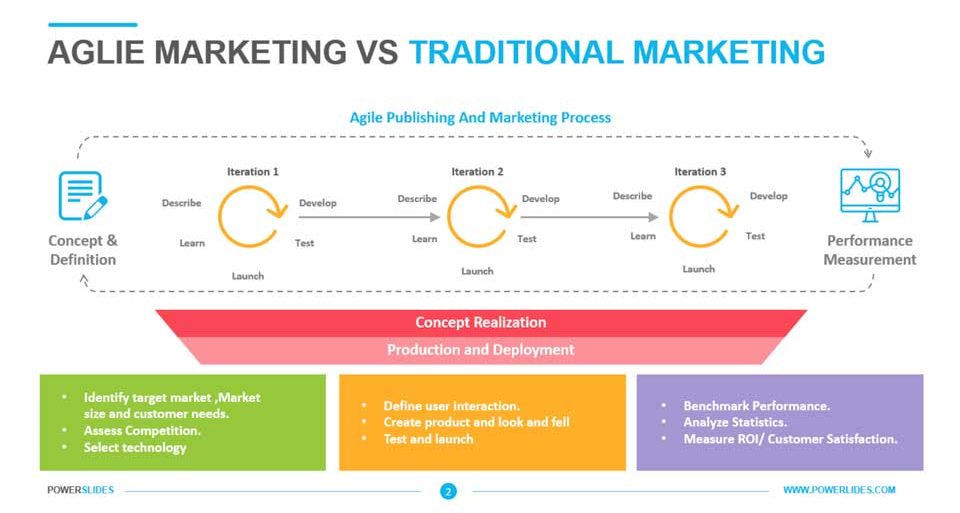Agile marketing is undoubtedly the future. Focused on creating content that attracts target audiences, it helps convert browsers into buyers. As an added benefit, it keeps you right in step with industry trends, so you stay ahead of the competition.
Time-consuming, expensive, and ineffective. traditional marketing is sluggish. In contrast, agile marketing is cost-effective and time-efficient, underpinned by collaboration rather than competition, and ranking data higher than opinions.
What is Agile Marketing?
A smart way to plan, execute and measure marketing activities in a flexible manner, the main goal of agile marketing is to create a customer-centric environment. This is where all marketing activities focus on customers, exploring their preferences and pain points.
This cross-functional marketing strategy concentrates on incremental deliveries. Using agile development principles (originally developed for the software field). agile marketing is a step-after-step iterative process that constantly tests underlying assumptions in quick sprint cycles.
The entire concept is fueled by steady feedback from target markets, ensuring nimble reactions to shifting consumer preferences. Broken down into basics, agile marketing involves six simple steps:

Step 1. Picking Pertinent Metrics
All marketing campaign goals must be measurable, which means using a metrics system that measures aspects such as acquisition, activation, retention, referrals, and revenues.
Step 2. Choosing the Right Goals
The most effective approach is to define just a couple of priorities every three months, with other metrics kept in a holding pattern. With the priority goals defined for each quarter, it’s time to plan each sprint. These exercises last a set length of time (rarely more than a week or two), with specific tasks and experiments performed that pursue each sprint goal.
Step 3. Generating A Growth Backlog
Build up a list of hypotheses to be tested, preferably through pinpointing insights in data, or even related articles or other reliable sources. These are added to the backlog and assigned to specific metrics for future evaluation.
Step 4. Selecting the Next Test
Making the best use of team talents, this stage scores the potential impacts of the next initiative, together with how easy it would be to generate, and confidence that it would actually work. The top-scoring options are selected for the next sprint.
Step 5. Testing and Analyses
As each initiative is launched, the entire team should be involved in the sprint process in some way: analytics, A/ B testing, user tests, and visible monitoring are all valid ways of gathering feedback.
Step 6. Retrospective, then Repeat
At the end of each sprint, a retrospective session for the entire team explores issues such as what worked well (and what didn’t), indicating points for improvement. All this experience is rolled over into the next sprint, with its own specific goals and metrics.

See how Transmyt can drive massive amounts of growth for your business.
-
SEO – Unlock massive amounts of traffic.
-
Content Marketing – Our team creates engaging content that will get shared + attract customers.
-
Paid Media – Effective paid strategies with clear ROI.
-
Website Development – Cutting-edge technology platforms.
Is It Worth Switching to Agile Marketing?
There are many advantages to an agile approach to marketing, with its dynamic approach rooted in regular feedback and solid data, rather than feelings and hunches. These benefits include:
- Businesses can make quick decisions based on trustworthy data, keeping pace with market conditions;
- Marketers can focus on customers, making better decisions through faster access to data;
- Customer satisfaction is enhanced, through rapid responses to reviews and feedback
How Agile Marketing Can Grow Your Business
An innovative approach that helps businesses grow, agile marketing makes good use of the latest technologies and solutions. It offers across-the-board advantages in many sectors. Here are five of the major upsides of agile marketing:
- It’s cost-effective; as less time, money, and effort go to planning, implementation, and measurements.
- It boosts revenues by keeping pace with rapidly-shifting market trends;
- It deepens customer engagement, responding rapidly to their needs with customized content;
- It steps up productivity by providing faster feedback on buyer experiences;
- It enhances brand awareness by creating content that is relevant to target markets.
Agile Marketing Principles
The world has changed drastically since 2020. This ground shift is triggering demands for more flexible approaches that help companies navigate their way through new social precedents that are reshaping customer needs and demands.
Agile marketing is just one of these new evidence-based tools, developed in response to rapidly-changing marketplaces. Here are its four key principles:
- Focused on delivering customer value early and often, with positive business outcomes;
- Learning through doing, rating data higher than opinions and beliefs;
- Responding to changing circumstances seamlessly through foresight and flexibility rather than sticking to set plans;
- Cross-functional collaboration outranks corporate hierarchies, geographical fences, and departmental silos.
Agile Marketing Do’s
- Measure early and often, actively seeking feedback to make sure that campaigns are performing as expected;
- Show performance data to management, steering decisions on budget allocations and placements;
- Be willing to pivot, creating innovative marketing approaches and ruthlessly scrapping under-performing initiatives;
- Streamline go-lives (and ease pre-launch stress) by pruning away unnecessary sign-offs and hand-overs;
- Save time and money by repurposing high ROI content, particularly in different channels;
- Actively encourage brainstorming and thinking outside the box, even if some experiments go wrong;
- Stress the importance of collaboration and teamwork, rather than kowtowing to divas and stars;
- Keep teams flexible through cross-functional skill sets that are both complementary and synergistic;
- Discuss metrics with stakeholders at least once a quarter (maybe even once a month?) to keep them up-to-date on market trends in close to real-time;
- Keep a finger on the pulse of what’s happening in the world, ready to piggyback on current events for added visibility;
Agile Marketing Don’ts
As might be expected, the importance of flexibility and creativity means that the agile marketing Don’ts list is far shorter than all its exciting, pro-active dos. However, there are a few pitfalls to avoid:
- Don’t spend a lot of time on upfront planning that’s set in stone, as markets change constantly;
- Don’t keep doing what you’ve always done, without stepping back and asking why;
- Don’t accept tasks automatically, just because C-suite aspirants think they know what customers want;
- Don’t overburden teams with last-minute changes to deliverables, as this will hamper productivity;
- Don’t rely heavily on outside expertise that might not always be available when needed;
- Don’t be overly cautious – if in doubt, take a risk, check the metrics, and then cancel, pivot or tweak as required.
Implementing Agile Marketing Successfully
More than just a data-based strategy, agile marketing also involves tactics, using insights and information to steer decisions. Often involving a real about-turn in corporate culture, it replaces guesswork and gut feelings with live data, sourced straight from the market.
Want more insights?
Subscribe to our weekly marketing tips and advice, delivered straight to your inbox.
Oops! We could not locate your form.
Keep Reading
Want more? Here are some other blog posts you might be interested in.
The MVP—Minimum Viable Product—has become gospel in startup circles. Build fast, test fast, fail fast. But in today’s crowded market, viability ...
The startup myth goes like this: work 20-hour days, pivot constantly, chase the high of the new. That’s what makes a ...
Most founders build their first leadership teams for speed, comfort, and alignment. Understandably, you’re strapped for time and need people who ...
For founders and growing companies
Get all the tips, stories and resources you didn’t know you needed – straight to your email!



